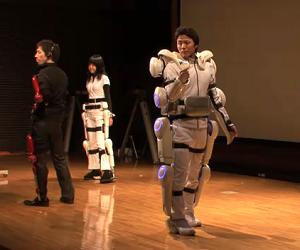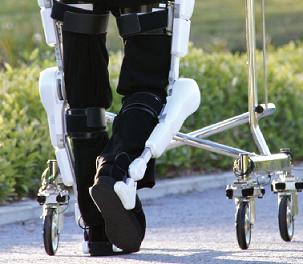
The cybernetically enhanced musclemen of the future have arrived! …at Japanese nursing homes. Cyberdyne, makers of Robot Suit HAL, have been renting out the lower half of the powerful exoskeleton to medical and elder care facilities in Japan since the fall of 2009. Able to give users up to 10 times their normal strength, HAL is the kind of technology that fuels my superhero fantasies, but creator Yoshiyuki Sankai at Tsukuba University wants these suits to be used for medicine and industry, not vengeance. Sankai’s International Forum on Cybernics 2011 gave exo fans some great new looks at different versions of the device and how they may fulfill their destiny to help humans care for the sick, or work harder in warehouses. Check out the video from the event below, followed by a great look at the first US trial of HAL during CES 2011. The anime-loving child inside me is crying over the fact that HAL will never be designed to let us become Iron Man, but I’m still pretty impressed by what Cyberdyne has managed to create so far.
As near as I can determine, the International Forum on Cybernics was created expressly to show off HAL to an international crowd. That’s a little heavy-handed, but I can’t argue with the results. Sankai and Cyberdyne gave a range of cool-looking presentations meant to showcase the successes they’ve had with different models of the HAL exoskeleton. The lower leg version has been commercially available for more than a year now. According to comments made by Cyberdyne representatives earlier in 2011, there are about 160 units in the field in Japan, each renting out for around $1500 US per month. They’re hoping to expand this program significantly in the near term. It’s kind of amazing to see the rows and rows of robot legs Cyberdyne had on display at IFC, they look ready to march to your door at any moment (0:57 in the video). The full body version of HAL (which includes augmentation for arms and lifting) is still in development, but a single limb device could be available very soon. Check out all these variations, along with explanations from Sankai himself, in the following video from DigoInfo News.
For those unfamiliar with HAL, the “hybrid assist limb” uses a combination of automated and sensing technologies to have the robotic appendages follow your movements. This system allows HAL to anticipate, rather than simply react, to your muscle contractions. That means that, although users may seem like they are simply walking with metal pods strapped to their legs, HAL is actually doing all the work for them. At CES 2011, two months before the IFC, Evan Ackerman, a tech blogger and all around nice guy, got a chance to wear the HAL legs for himself and take them for a spin. He’s probably the first member of the press to test drive the device in the US. Watch his steps go from tentative to assured in the following video from IEEE Spectrum.
You can read more about Evan’s time with HAL in the post he wrote for DVice.
As stilted as some of HAL’s leg movements appear, the lower body system may represent the best of the current exoskeleton technology for commercial use. That’s a good thing for Cyberdyne, but a little sad for the world. HULC, the Lockheed Martin leg device, is probably faster and more nimble, but it’s also only for military use at the moment, and still hasn’t seen action in the field. Lower body exoskeletons designed for paraplegics seem just as slow as HAL, look to be slightly more expensive, and haven’t been available as long. These could all be revolutionary devices, but none seems ready to serve as the legs of a superhero.
The arm situation is worse. HAL isn’t ready to debut its upper body for sales yet. Many other companies aren’t even attempting to do work with arms. Of the ones that do, the most powerful can’t run on a battery pack, it needs to use an electrical tether. Speaking of batteries, HAL is only able to run for less than three hours before running out of juice. Forget superheroes, that may not even be enough for the nurses and orderlies who need to use these devices in medical facilities.

Yet Sankai’s vision of robotically augmented humans remains strong. The current state of affairs is still relatively primitive but Cyberdyne seems dedicated to bringing what it can to the market as soon as possible. They’ve organized conferences to help spread the word, they’ve constantly put themselves on display, and they seem to be steadily improving their technology to match their own hype. The videos above truly are impressive. Not because they fulfill any of our bloated expectations about what an exoskeleton should look like, but because they show a real, usable technology that is commercially viable and available. It may take years before you or I will be able to strap on a full body exoskeleton like HAL and multiply our strength by a factor of 10, but the technology that is ready to use in 2011 is still pretty damn awesome.
[screen capture credit: DigInfo TV]
[image credit: International Forum on Cybernics 2011]
[sources: DigInfo, IEEE Spectrum, Cyberdyne]


